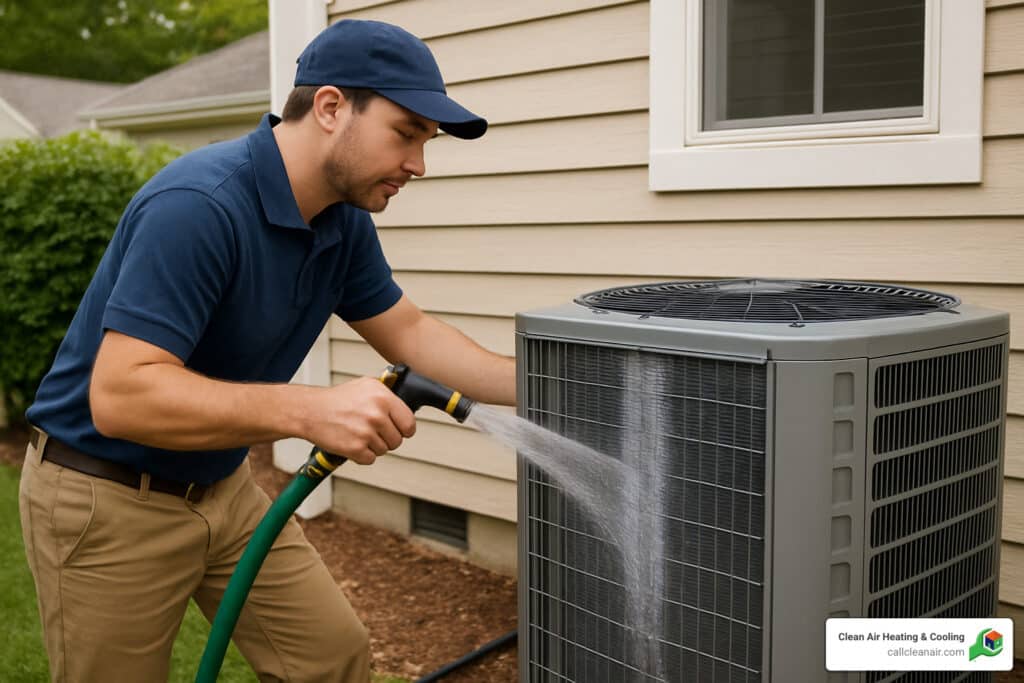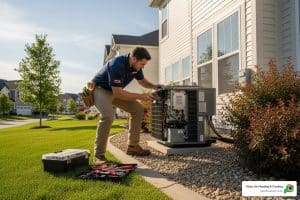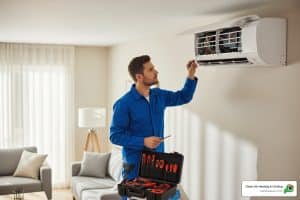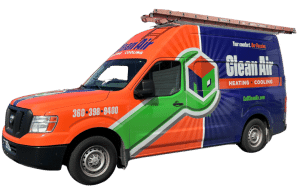Why AC Unit Maintenance is Essential for Your Home
AC unit maintenance is the key to keeping your cooling system running efficiently and your energy bills low. Here’s what you need to know:
Essential AC Maintenance Tasks:
- DIY Tasks: Change filters monthly, clear debris around outdoor unit, straighten fins, check condensate drain
- Professional Tasks: Refrigerant checks, electrical inspections, motor lubrication, duct testing
- Frequency: Professional service annually, DIY tasks seasonally
- Cost Savings: Up to 15% reduction in energy consumption with clean filters
- Benefits: Lower utility bills, cleaner air, fewer repairs, extended equipment life
Regular maintenance prevents the costly breakdowns that leave families uncomfortable during hot summer days. As one HVAC expert puts it: “Regular cleaning and maintenance will save you money and extend the life of your heat pump or HVAC unit.”
The numbers speak for themselves: U.S. homeowners spend about $29 billion annually on air conditioning energy costs. Replacing a clogged filter alone can reduce your AC’s energy consumption by up to 15%. That means a $100 monthly cooling bill could drop by $15 just from this simple task.
The good news? Many maintenance tasks are simple enough for homeowners to handle safely. Others require professional expertise to avoid damage or safety hazards.
I’m Colin Matei, Owner and President of Clean Air Heating & Cooling, and I’ve spent years helping Whatcom, Skagit, and Snohomish County families optimize their AC unit maintenance routines. My experience has shown that homeowners who follow proper maintenance schedules enjoy significantly lower energy bills and fewer emergency repair calls.

Basic AC unit maintenance glossary:
Why Regular Maintenance Matters
Regular AC unit maintenance delivers measurable benefits that impact your wallet, health, and comfort. Let’s break down exactly why this investment pays off:
Energy Cost Savings: With U.S. homeowners spending $29 billion annually on air conditioning, even small efficiency improvements create substantial savings. A properly maintained system uses 15% less energy than one with clogged filters. For the average household spending $200 monthly on cooling, that’s $30 saved every month during peak season.
Mold Prevention and Indoor Air Quality: Dirty AC systems become breeding grounds for mold and allergens. When evaporator coils accumulate dust and moisture sits in drain pans, microbial growth flourishes. These contaminants then circulate throughout your home, triggering asthma and allergies. Scientific research on indoor humidity and mold shows that proper AC maintenance significantly reduces indoor air pollutants.
Extended Equipment Lifespan: A quality room air conditioner should last more than 10 years, while complex central systems can exceed 15 years with proper care. However, neglected systems fail prematurely. Dirty coils force compressors to work harder, clogged filters restrict airflow causing freeze-ups, and bent fins reduce heat transfer efficiency.
Fewer Emergency Repairs: Regular maintenance catches small issues before they become expensive failures. A loose electrical connection identified during routine service prevents a complete system shutdown during the hottest day of summer. Similarly, clearing condensate drains prevents water damage and mold growth.
Reduced Carbon Footprint: Efficient AC systems consume less electricity, reducing your environmental impact. When your system runs optimally, it requires less energy to achieve the same cooling effect, contributing to overall energy conservation efforts.
The research is clear: homeowners who invest in regular AC unit maintenance enjoy lower utility bills, healthier indoor air, and fewer unexpected repair costs. It’s preventive medicine for your HVAC system.
DIY AC Unit Maintenance Checklist
Many AC unit maintenance tasks are well within the capabilities of careful homeowners. Following proper safety procedures and using the right techniques, you can handle routine maintenance that keeps your system running efficiently between professional visits.
Safety First: Before beginning any maintenance work, always shut off power to your AC unit at both the indoor breaker and outdoor disconnect switch. Never attempt maintenance on a live system.
Key DIY Tasks:
- Monthly: Check and replace air filters
- Seasonally: Clear debris around outdoor unit, straighten fins, check condensate drain
- Annually: Deep clean condenser coils, level the unit pad, inspect refrigerant lines
Essential Safety Guidelines:
- Maintain 2-foot clearance around outdoor units for proper airflow
- Use gentle garden hose pressure, never a pressure washer on fins
- Straighten bent fins carefully with a butter knife or fin comb
- Check condensate drain for proper flow and clear blockages
- Ensure the outdoor unit pad remains level using rot-resistant shims
- Adjust thermostat settings appropriately for energy savings
Let’s explore the specific steps for safe, effective seasonal maintenance.
Power Down & Gear Up
Before touching any part of your AC system, proper shutdown and safety preparation are crucial. This isn’t just about convenience—it’s about preventing electrical shock and equipment damage.
Power Shutdown Sequence:
- Turn off the thermostat or set it to “off” mode
- Locate the outdoor disconnect switch near your condenser unit
- Flip the breaker in your electrical panel labeled for the AC system
- Wait at least 30 minutes before beginning work to allow capacitors to discharge
Safety Equipment:
- Insulated work gloves to protect hands from sharp fins
- Safety glasses to shield eyes from debris
- Voltage tester to confirm power is off
- Lockout tags to prevent accidental power restoration

Pro Tip: If you’re uncomfortable with electrical components or can’t locate the proper shutoffs, call a professional. It’s better to pay for expert service than risk injury or equipment damage.
Filter Care & Airflow Boost
Air filter maintenance is the single most important task homeowners can perform. According to the U.S. Department of Energy, replacing a clogged filter can reduce your air conditioner’s energy consumption by up to 15%.
Filter Types and MERV Ratings:
- Basic fiberglass filters (MERV 1-4): Capture large particles, need monthly replacement
- Pleated filters (MERV 5-8): Better particle capture, last 2-3 months
- High-efficiency filters (MERV 9-12): Excellent filtration but may restrict airflow in some systems
Monthly Filter Inspection:
- Remove the filter from its housing (usually near the indoor unit)
- Hold it up to light—if you can’t see through it clearly, it needs replacement
- Check the airflow arrow and install the new filter in the same direction
- Ensure the filter fits snugly with no gaps around the edges
Special Considerations:
- Pet owners: Change filters monthly due to increased hair and dander
- Allergy sufferers: Consider MERV 8-11 filters for better particle capture
- High-efficiency filters: Monitor system performance—overly restrictive filters can cause coil freeze-ups
For detailed guidance on filter selection and replacement schedules, check out our comprehensive guide on filter changes.
Outdoor Condenser Deep-Clean
The outdoor condenser unit does the heavy lifting of heat removal, making its cleanliness crucial for efficiency. Debris buildup can reduce airflow by up to 30%, forcing your system to work harder and consume more energy.
Debris Removal Process:
- Remove the top fan cage by unscrewing the fasteners
- Lift out leaves, twigs, and debris by hand
- Use a shop vacuum for smaller particles
- Clear vegetation and objects within 2 feet of the unit
Fin Cleaning Technique:
- Spray fins gently with a garden hose from inside the unit, working outward
- Use commercial fin cleaner for stubborn dirt buildup
- Never use a pressure washer—it can bend the delicate aluminum fins
- Work from top to bottom to avoid pushing debris deeper into the unit
Fin Straightening:
Bent fins block airflow and reduce efficiency. Use a butter knife or specialized fin comb to gently straighten bent areas. Work carefully—these fins are delicate and can break if handled roughly.

Vegetation Management:
Trim shrubs and plants to maintain proper clearance. Overgrown vegetation restricts airflow and can damage refrigerant lines. Keep the area clean and well-maintained for optimal performance.
Indoor Coil & Condensate Drain
The indoor evaporator coil and condensate drain system require different maintenance approaches but are equally important for system health and indoor air quality.
Evaporator Coil Care:
- Dust the coil gently with a soft brush
- Use no-rinse coil spray cleaner for deeper cleaning
- Never use water directly on electrical components
- Clean the drain pan with a 50/50 bleach-water solution to prevent mold
Condensate Drain Maintenance:
- Locate the drain line (usually a PVC pipe near the indoor unit)
- Use a wet/dry vacuum to suction out algae and debris for 2-3 minutes
- Pour a cup of bleach solution down the drain to kill remaining microorganisms
- Add algae prevention tablets to the drain pan
Warning Signs of Drain Problems:
- Musty odors from vents
- Water pooling around the indoor unit
- High humidity levels despite AC operation
- Visible mold growth near the unit
Clogged drains can cause water damage and create ideal conditions for mold growth. If you notice any of these signs, address the issue immediately or call a professional.
Essential Tools for AC Unit Maintenance
Having the right tools makes AC unit maintenance safer and more effective. Here’s what every homeowner should have in their HVAC toolkit:
Basic Tool Kit:
- Fin comb: For straightening bent condenser fins ($10-15)
- Wet/dry vacuum: Essential for drain line cleaning ($50-100)
- Torpedo level: To check unit pad levelness ($15-25)
- No-rinse coil spray: For safe coil cleaning ($8-12)
- Rot-resistant shims: For releveling settled units ($5-10)
Additional Helpful Tools:
- Soft-bristle brush for gentle cleaning
- Garden hose with adjustable nozzle
- Voltage tester for safety verification
- Basic hand tools for removing panels

Investment Perspective:
While the initial tool investment might seem significant, these tools last for years and pay for themselves through reduced service calls and improved system efficiency.
Professional AC Maintenance: What to Expect & When to Call
While DIY maintenance handles routine tasks, professional service addresses complex systems that require specialized knowledge, tools, and certifications. Licensed technicians can safely work with refrigerant, electrical components, and intricate mechanical systems.
Professional Service Scope:
- Refrigerant level checks and leak detection: Only EPA-certified technicians can legally handle refrigerant
- Electrical connection inspection and tightening: Prevents dangerous loose connections
- Motor lubrication and bearing service: Extends equipment life and reduces noise
- Duct leak testing and sealing: Can recover up to 30% of lost airflow
- Comprehensive safety system testing: Ensures all protective mechanisms function properly
Service Frequency:
- Annual tune-ups: Minimum for most systems, preferably in spring
- Bi-annual service: Recommended for systems over 10 years old or in harsh environments
- Seasonal preparation: Spring for cooling season, fall for heating systems
Cost Expectations:
Professional maintenance typically ranges from $65-$200 depending on system complexity and local market rates. This investment often prevents repairs costing hundreds or thousands of dollars.
Warranty Considerations:
Many manufacturer warranties require professional maintenance to remain valid. Skipping professional service could void your warranty coverage, leaving you responsible for expensive repairs.
When to Call Immediately:
- Refrigerant leaks (ice buildup, hissing sounds, poor cooling)
- Electrical issues (burning smells, frequent breaker trips)
- Mechanical problems (unusual noises, vibrations)
- Performance issues beyond normal wear
Scientific research on energy savings demonstrates that professional maintenance can improve efficiency by 5-15% beyond what homeowners can achieve alone.
For comprehensive coverage and peace of mind, consider our HVAC Maintenance Plans that combine professional expertise with convenient scheduling.
Seasonal & Long-Term Tips: Winter Prep, Window Seals, and Common Mistakes
Proper AC unit maintenance extends beyond the cooling season. Year-round care and avoiding common mistakes ensure optimal performance and longevity.
Winter Preparation:
- Cover only the top of outdoor units, never the sides—full covers trap moisture and encourage pest nesting
- Heat pump considerations: Slope the pad slightly away from the foundation to handle defrost runoff
- Window unit care: Remove and store units indoors, or seal gaps around permanently installed units
Common Maintenance Mistakes to Avoid:
- Never use pressure washers on condenser coils—the high pressure bends fins and forces debris deeper
- Don’t block indoor vents with furniture or curtains—this disrupts airflow balance
- Avoid oversized filters that restrict airflow and can cause system freeze-ups
- Don’t ignore small issues—minor problems often escalate into major failures
Window Seal Inspection:
For room air conditioners, check the seal between the unit and window frame annually. Damaged seals allow conditioned air to escape, reducing efficiency and increasing energy costs.
Duct Insulation:
Ensure ductwork in unconditioned spaces (attics, crawl spaces) is properly insulated. Ducts can lose up to 30% of airflow through leaks and poor insulation.
Thermostat Optimization:
- Use programmable settings to reduce energy consumption when away
- Avoid extreme temperature changes that force the system to work harder
- Consider smart thermostats for optimal efficiency

Long-term Performance Tips:
- Keep detailed maintenance records for warranty purposes
- Monitor energy bills for unusual increases that might indicate problems
- Schedule professional inspections before peak seasons
- Consider system upgrades when efficiency improvements justify the investment
For more comprehensive guidance, explore our detailed AC Unit Maintenance Tips resource.
Frequently Asked Questions about AC Unit Maintenance
How often should I schedule professional service?
Annual tune-ups are the minimum for most AC systems, with spring being the optimal timing. This allows technicians to address any issues before peak cooling season when service calls are in high demand.
Bi-annual service is recommended for:
- Systems over 10 years old
- Units in harsh environments (coastal areas, high dust, heavy use)
- Homes with pets that shed heavily
- Systems that also provide heating (heat pumps)
Seasonal considerations: Spring service ensures cooling readiness, while fall service prepares heating systems and assesses wear from the cooling season.
What are signs my AC needs immediate repair?
Immediate attention required:
- Warm air from vents despite proper thermostat settings
- Short cycling (frequent on/off cycles) indicating control or refrigerant issues
- Ice buildup on refrigerant lines or indoor coils
- Dramatically higher energy bills without increased usage
- Strange noises like grinding, squealing, or rattling
- Burning smells that could indicate electrical problems
Don’t wait for complete failure: These symptoms often worsen rapidly and can lead to more expensive repairs or complete system replacement.
Does maintenance really cut energy costs?
The data is compelling: According to Department of Energy statistics, U.S. homeowners spend about $29 billion annually on air conditioning. Proper maintenance can reduce these costs significantly:
- Clean filters alone: Up to 15% energy savings
- Sealed ductwork: Prevents up to 30% airflow loss
- Proper refrigerant levels: Ensures optimal heat transfer efficiency
- Clean coils: Maintains heat exchange effectiveness
Real-world example: A household spending $200 monthly on cooling could save $30-50 through proper maintenance—that’s $360-600 annually, far exceeding the cost of professional service.
Additional benefits: Beyond energy savings, maintenance prevents costly emergency repairs and extends equipment life, providing compound financial benefits over time.
Conclusion
AC unit maintenance doesn’t have to be complicated or overwhelming. By combining simple DIY tasks with professional expertise, you can keep your system running efficiently while protecting your investment and ensuring your family’s comfort.
Key takeaways:
- Monthly filter changes can save 15% on energy costs
- Basic DIY maintenance prevents most common problems
- Professional service addresses complex systems safely
- Seasonal preparation prevents emergency breakdowns
- Proper maintenance extends equipment life significantly
At Clean Air Heating & Cooling, we’ve helped thousands of families in Whatcom, Skagit, and Snohomish Counties optimize their HVAC systems. Our 25% utility savings guarantee reflects our confidence in proper maintenance practices, and our 480+ five-star Google reviews demonstrate our commitment to customer satisfaction.
Whether you’re tackling DIY maintenance or need professional service, consistent care is the key to optimal performance. Don’t wait for problems to develop—proactive maintenance always costs less than reactive repairs.
Ready to optimize your AC system’s performance? Contact us to learn more about our comprehensive HVAC services and maintenance programs designed specifically for Northwest Washington’s climate and conditions.
Your comfort, efficiency, and peace of mind are worth the investment in proper AC unit maintenance.





